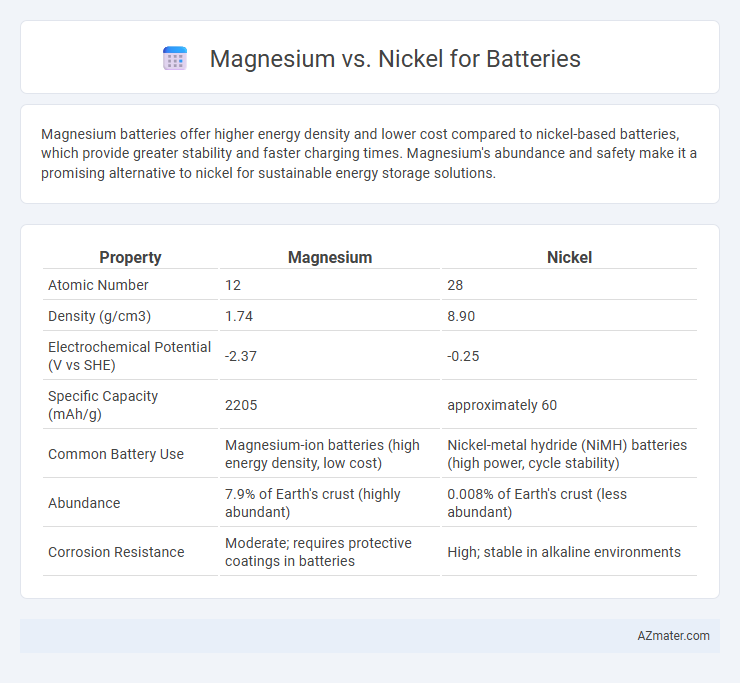Magnesium batteries offer higher energy density and lower cost compared to nickel-based batteries, which provide greater stability and faster charging times. Magnesium's abundance and safety make it a promising alternative to nickel for sustainable energy storage solutions.
Table of Comparison
| Property | Magnesium | Nickel |
|---|---|---|
| Atomic Number | 12 | 28 |
| Density (g/cm3) | 1.74 | 8.90 |
| Electrochemical Potential (V vs SHE) | -2.37 | -0.25 |
| Specific Capacity (mAh/g) | 2205 | approximately 60 |
| Common Battery Use | Magnesium-ion batteries (high energy density, low cost) | Nickel-metal hydride (NiMH) batteries (high power, cycle stability) |
| Abundance | 7.9% of Earth's crust (highly abundant) | 0.008% of Earth's crust (less abundant) |
| Corrosion Resistance | Moderate; requires protective coatings in batteries | High; stable in alkaline environments |
Introduction to Magnesium and Nickel in Batteries
Magnesium and nickel are critical materials in battery technology due to their distinct electrochemical properties. Magnesium offers high volumetric capacity and abundance, making it a cost-effective choice for rechargeable batteries with enhanced energy density. Nickel plays a vital role in battery cathodes, especially in nickel-cadmium and nickel-metal hydride cells, providing excellent cycle life and energy output.
Chemical Properties: Magnesium vs Nickel
Magnesium exhibits a higher theoretical capacity (2205 mAh/g) and lower atomic weight (24.3 g/mol) compared to nickel (Ni, 58.7 g/mol), making it advantageous for lightweight energy storage. Chemically, magnesium forms more stable and less corrosive oxide layers (MgO) compared to nickel oxides, which affects electrode durability and battery cycle life. Nickel's multiple oxidation states (Ni2+, Ni3+) enable efficient redox reactions but often lead to higher internal resistance and capacity fade relative to magnesium-based anode materials.
Energy Density Comparison
Magnesium batteries offer a higher volumetric energy density than nickel-based batteries due to magnesium's ability to transfer two electrons per ion, increasing charge capacity. Nickel batteries, particularly nickel-metal hydride (NiMH), typically provide higher specific energy but lower volumetric energy density compared to magnesium systems. The energy density advantage of magnesium batteries supports longer-lasting, compact energy storage solutions critical for electric vehicles and portable electronics.
Cost and Abundance of Materials
Magnesium offers significant cost advantages over nickel due to its abundant availability in the Earth's crust, making it one of the most plentiful and affordable metals for battery production. Nickel, while commonly used in current lithium-ion batteries, faces supply constraints and price volatility driven by demand in electric vehicle manufacturing. The lower extraction and processing costs of magnesium contribute to its potential as a cost-effective alternative for large-scale energy storage solutions.
Environmental Impact and Sustainability
Magnesium batteries offer a more sustainable alternative to nickel-based batteries due to magnesium's abundance, lower toxicity, and greater recyclability, which significantly reduces environmental degradation. Unlike nickel, which is often mined in ecologically sensitive areas and involves energy-intensive extraction processes, magnesium extraction produces fewer greenhouse gases and less ecological disruption. The use of magnesium in batteries aligns with increasing demand for environmentally friendly energy storage solutions by minimizing resource depletion and supporting circular economy initiatives.
Performance in Rechargeable Batteries
Magnesium batteries offer higher volumetric capacity and better safety due to their dendrite-free deposition compared to nickel-based batteries, which often face capacity fading from dendrite growth. Nickel batteries provide superior conductivity and faster charge-discharge rates, making them suitable for high-power applications but with moderate energy density. Emerging research highlights magnesium's potential for longer cycle life, while nickel's established technology ensures reliability and widespread availability in rechargeable battery markets.
Safety and Stability Considerations
Magnesium batteries offer enhanced safety and stability due to their lower dendrite formation risk compared to nickel-based batteries, reducing the likelihood of short circuits and thermal runaway. Nickel batteries, while providing high energy density, often require complex management systems to prevent overheating and improve overall safety. The inherent chemical properties of magnesium contribute to more stable electrode interfaces, making magnesium batteries a promising option for safer, long-lasting energy storage solutions.
Technological Challenges and Advances
Magnesium batteries offer higher volumetric energy density and greater abundance than nickel, but face significant challenges including sluggish ion diffusion and dendrite formation that hinder cycle life and safety. Advances in solid-state electrolytes and nanostructured cathode materials have improved magnesium ion mobility, addressing these inefficiencies. In contrast, nickel-based batteries benefit from established manufacturing techniques and high power density, yet suffer from capacity fade and thermal instability, which ongoing innovations in cathode coatings and battery management systems aim to mitigate.
Current Applications and Market Trends
Magnesium batteries are emerging as a promising alternative to nickel-based batteries due to their higher energy density and abundant raw materials, with growing applications in large-scale energy storage and electric vehicles. Nickel batteries, particularly lithium-nickel-cobalt-aluminum oxides (NCA) and lithium-nickel-manganese-cobalt oxides (NMC), dominate the current EV and portable electronics markets because of their mature technology and superior cycle life. Market trends indicate increasing investment in magnesium battery research to overcome challenges like electrolyte stability, while nickel battery production faces supply chain pressures and environmental concerns driving innovations in sustainable sourcing and recycling.
Future Prospects for Magnesium and Nickel Batteries
Magnesium batteries offer promising future prospects due to their higher volumetric capacity and abundant availability compared to nickel, potentially leading to more cost-effective and sustainable energy storage solutions. Nickel batteries, particularly nickel-cadmium and nickel-metal hydride, possess established infrastructure and higher energy density but face challenges with toxicity and resource depletion. Ongoing research aims to enhance magnesium battery electrolyte stability and electrode materials, positioning magnesium as a competitive alternative for next-generation rechargeable batteries in electric vehicles and grid storage.

Infographic: Magnesium vs Nickel for Battery
 azmater.com
azmater.com